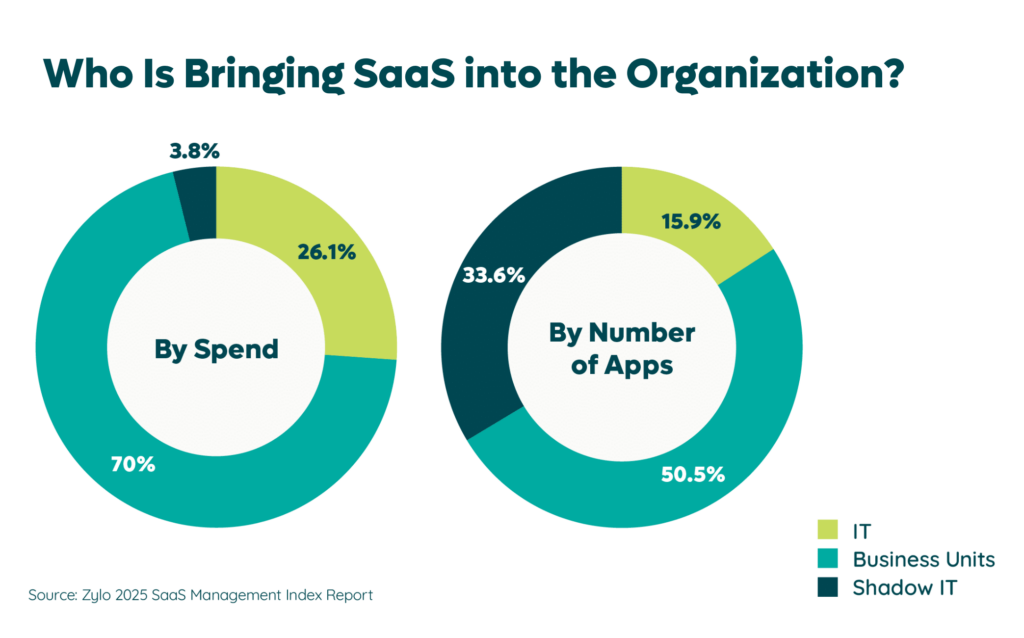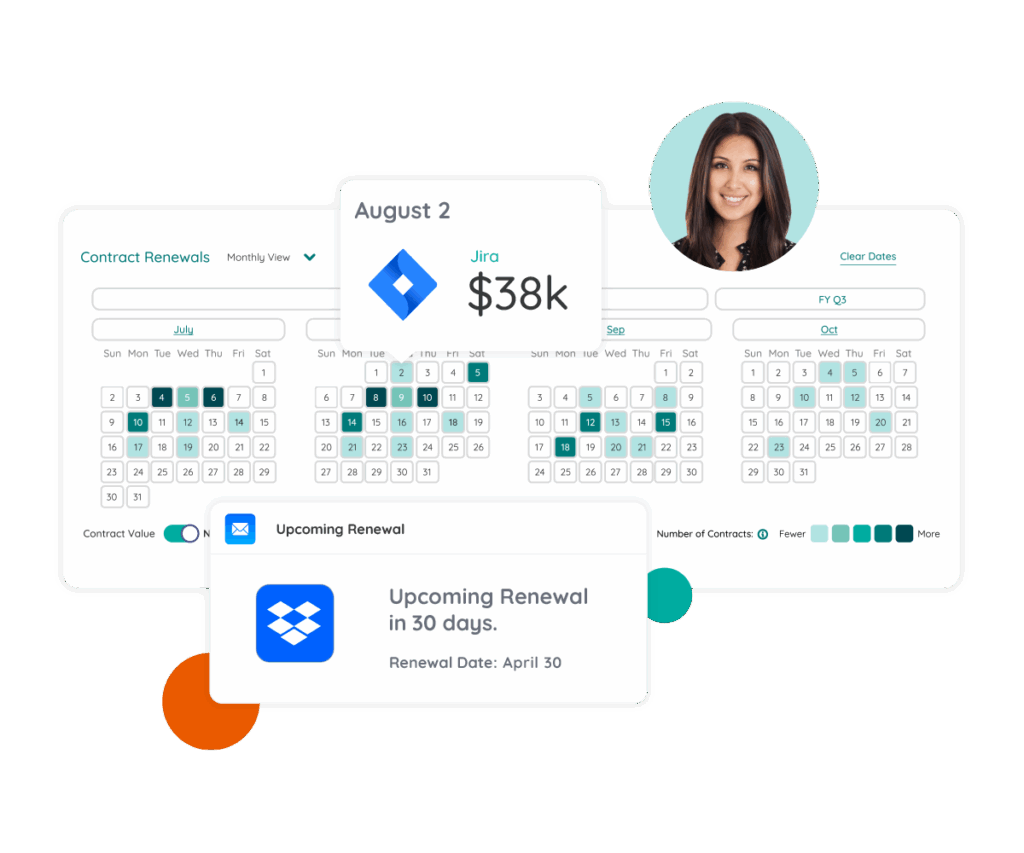
How to Build a Savings Pipeline for SaaS Renewals
Table of Contents ToggleWhat Is a SaaS Savings Pipeline?Why Managing SaaS...
Back
Back
Search for Keywords...
Blog

Table of Contents
In the past, all software spending at an organization went through IT procurement or sourcing. Software sourcing typically involved a formal RFP and a lengthy decision-making process. But those days are long gone, largely thanks to the rapid shift to software-as-a-service (SaaS) and other cloud-based delivery models. The future is now SaaS Management for Procurement teams.
Though SaaS is a relatively new business model, it’s one that’s quickly gained traction. According to Zylo’s data, there are more than 22,000 SaaS companies worldwide. On top of that, IDC reported that SaaS spending overtook on-premises software spending in 2022 for the first time. Then, in 2023, SaaS comprised 60% of total software spending, and that number will probably keep growing.
The right SaaS tools play an important role in boosting the efficiency of your employees—and your entire organization. In fact, as a procurement professional, you probably depend on several SaaS tools to do your job well.
However, SaaS has also caused a big shift in software sourcing and the way procurement professionals do their jobs. In many ways, it’s made things much more challenging.
There are many good reasons why companies are switching to SaaS: lower costs, simple implementation, and enhanced security – just to name a few.
But there’s no denying that SaaS can also cause some pretty big headaches for procurement professionals.
When teams and organizations throughout the company purchase SaaS, procurement leaders have very little visibility into an organization’s overall application spend and usage. Unmanaged SaaS growth leads to uncontrolled costs and risks. Developing accurate budgets, identifying cost optimization opportunities, and understanding adherence to software purchasing policies become more challenging.
SaaS has never been easier to acquire. It typically only requires a credit card number and a small amount of contact info. Because it’s so easy, business units and individuals often purchase their own applications without the involvement of IT Procurement.

At an average organization, business units and individuals are responsible for a significant portion of SaaS spending—74% of all SaaS expenditures and 84% of SaaS inventory. Notably, about 6.6% of employees have purchased a SaaS application via expense.
However, identifying these purchases is complex, as 51% of software expenses are miscategorized or miscoded in expense reports. This miscategorization creates challenges for organizations if they want a clear and accurate view of their SaaS expenditures, complicating efforts to effectively manage and optimize these investments.
And that’s a big problem for procurement professionals.
A key responsibility of every Procurement team is to identify cost savings opportunities. But that’s difficult (if not impossible) to do when you’re unsure what applications are in use at your organization.
The average organization utilizes 275 applications and incurs an annual expenditure of $49M. Alarmingly, nearly half of these applications are classified as shadow IT, operating without formal oversight or approval. This segment, especially within the long tail of applications, presents numerous cost-saving opportunities. Organizations can significantly reduce costs by strategically managing these less visible applications.

Unfortunately, you’re probably already paying for unused (or underused) SaaS applications. The average organization wastes 53% of SaaS licenses — equating to $21M annually.
Because so many employees are purchasing SaaS applications via expense reimbursement, your organization is probably paying for tools with redundant functionality. You might even be paying for the same application more than once!
Procurement teams often find themselves unprepared for SaaS contract renewals due to a lack of visibility into spending, usage, and contract details. This is a significant issue since most organizations experience around 200 renewals annually — nearly one per business day. Here’s a breakdown of the key issues:
These gaps in information force Procurement to make reactive decisions, often resulting in suboptimal renewals. Without data, you can’t decide which renewals to cancel and which prices you can negotiate.
4 Need-to-Know SaaS Stats for Procurement Leaders
Learn MoreIf this all sounds familiar, you’re certainly not alone. The rise in SaaS brings a host of frustrations for nearly all procurement professionals.
However, SaaS is here to stay, so procurement leaders must adapt their approach to SaaS.
The good news? SaaS Management can make the lives of procurement leaders a whole lot easier.
Many procurement professionals have realized the need to develop a SaaS Management strategy for their organizations. But what is SaaS Management, and why is it so important?
Practicing SaaS Management means proactively monitoring and managing the full lifecycle of a company’s SaaS applications portfolio. This includes:
Organizations that practice SaaS Management can ensure their teams have the tools they need to be effective while reducing the unnecessary costs and risks of SaaS growth.
The foundation of effective SaaS Management is full visibility into all the applications your organization uses. After all, you can’t manage something if you don’t even know it exists! SaaS Management provides a clear picture of how much is being spent on SaaS, who’s doing the spending, and the value each investment brings to the organization.
Organizations practicing SaaS Management maintain all key contract details for SaaS applications in a single system of record, ensuring that Procurement, IT, and business owners use the same source of truth for decision-making.

SaaS inventory management complements this by creating a comprehensive record of all your SaaS applications and spending. This process, vital for identifying software redundancies, security risks, and shadow IT, is streamlined through a SaaS Management Platform (SMP) like Zylo.
Unlike traditional methods such as spreadsheets, Zylo automates the discovery process, ensuring that even applications unknown to IT and Procurement are accounted for. This automation not only centralizes data but also provides real-time insights and a holistic view of the SaaS ecosystem, enhancing collaboration and decision-making across stakeholders.
Gaining full visibility into SaaS purchases means you’re in a better position to:
When you have a clear picture of all SaaS applications in use, it’s a lot easier to identify opportunities for your organization to cut costs and risk. And there are a number of effective ways to do that.
Once you’ve achieved comprehensive visibility into all SaaS purchases within your organization, numerous cost-reduction opportunities emerge. By identifying and rationalizing redundant applications, you can eliminate unnecessary overlap. Consolidating duplicate instances of the same application procured from multiple sources allows for better rate negotiations.

Reducing shadow IT by limiting expense spending helps control unauthorized acquisitions. Additionally, rightsizing licensing at renewal based on actual usage data ensures you only pay for what you truly need, further optimizing costs.
Proactively managing SaaS renewals requires full knowledge of upcoming dates and details for each application purchase. Establishing a SaaS renewal calendar can significantly aid in avoiding surprises. If the calendar is in your SMP, you can set up alerts to notify you when a renewal is approaching. We recommend alerts at 120, 90, and 60 days before renewal to give you ample time to gather necessary information and collaborate with the application purchaser.

Being proactive allows you to work with IT or Software Asset Management to run license reclamation workflows, ensuring you only renew necessary licenses. It also gives you the opportunity to thoroughly understand your licensing needs and benchmark pricing, positioning you to negotiate more effectively with vendors.
Leading organizations are adopting SaaS Management because they understand it’s a powerful, proven way to cut unnecessary costs and risks.
But today, the average organization maintains 275 applications. If you spent your time manually managing each of these applications, you wouldn’t have time for more strategic initiatives. What’s more, spreadsheet-driven record keeping leaves a lot of room for error – and quickly becomes outdated. After all, new applications enter and leave active use regularly.
Instead, consider partnering with a SaaS discovery and management provider like Zylo.
Zylo provides specific benefits for Procurement teams by enhancing their ability to manage SaaS effectively. Here are a few ways Zylo can help you and your Procurement team:
To see how Zylo simplifies managing SaaS for procurement leaders, request a demo of the leading SaaS Management platform today.

Table of Contents ToggleWhat Is a SaaS Savings Pipeline?Why Managing SaaS...

Table of Contents ToggleWhat FinOps Means in the Modern Cloud EnvironmentWhy...

Table of Contents ToggleSaaS Presents Unique Challenges to IT Procurement ProfessionalsWhy...

Table of Contents ToggleSaaS Presents Unique Challenges to IT Procurement ProfessionalsWhy...
| Cookie | Duration | Description |
|---|---|---|
| cookielawinfo-checkbox-analytics | 11 months | This cookie is set by GDPR Cookie Consent plugin. The cookie is used to store the user consent for the cookies in the category "Analytics". |
| cookielawinfo-checkbox-functional | 11 months | The cookie is set by GDPR cookie consent to record the user consent for the cookies in the category "Functional". |
| cookielawinfo-checkbox-necessary | 11 months | This cookie is set by GDPR Cookie Consent plugin. The cookies is used to store the user consent for the cookies in the category "Necessary". |
| cookielawinfo-checkbox-others | 11 months | This cookie is set by GDPR Cookie Consent plugin. The cookie is used to store the user consent for the cookies in the category "Other. |
| cookielawinfo-checkbox-performance | 11 months | This cookie is set by GDPR Cookie Consent plugin. The cookie is used to store the user consent for the cookies in the category "Performance". |
| viewed_cookie_policy | 11 months | The cookie is set by the GDPR Cookie Consent plugin and is used to store whether or not user has consented to the use of cookies. It does not store any personal data. |
